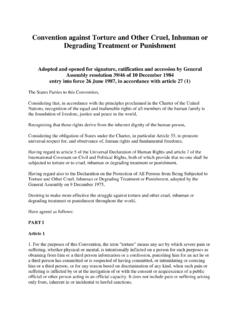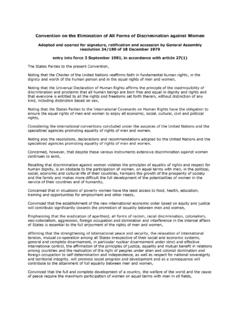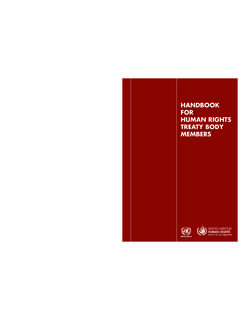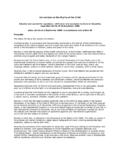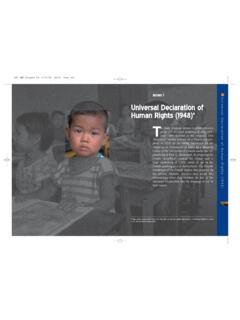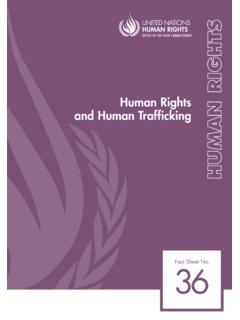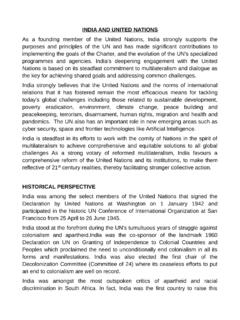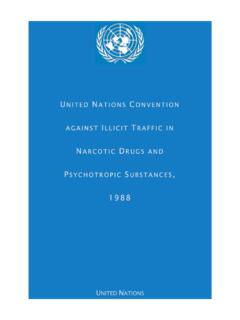Transcription of FOR VICTIMS OF CRIME AND HUMAN RIGHTS VIOLATIONS
1 Chapter 15 PROTECTION AND REDRESSFOR VICTIMS OF CRIMEAND HUMAN ObjectiveslTo sensitize the participants to the effects that CRIME and HUMAN RIGHTS VIOLATIONS mayhave on the victimslTo familiarize the participants with existing international legal rules governingprotection and redress for VICTIMS of CRIME and HUMAN RIGHTS violationslTo identify steps that States must take in order to provide redress and protection forvictims of CRIME and HUMAN RIGHTS violationslTo increase the participants awareness of their potential as judges, prosecutors andlawyers in protecting VICTIMS of CRIME and HUMAN RIGHTS violationsQuestionslWhat are the needs, problems and interests, in your view, of VICTIMS of ordinarycrime?lWhat types of legal protection and/or redress exist in your country for VICTIMS ofordinary CRIME ?
2 Give examples, such as cases of persons abused or maltreated bycommon criminals?lDo VICTIMS of CRIME face any special problems in the country in which you areexercising your professional responsibilities?lIf so, what are they and what is being done to remedy the situation?lAre there any particularly vulnerable groups of VICTIMS in your country, such asabused women and children?lIf so, what is done to protect them if they denounce the perpetrator of the abuse?lWhat measures, if any, are taken in the country in which you work to help protectother witnesses, such as informers, whose lives may be in danger following theirtestimony? HUMAN RIGHTS in the Administration of Justice: A Manual on HUMAN RIGHTS for Judges, Prosecutors and Lawyers749 Questions ( )lWhat types of legal protection and/or redress exist in your country for, among others,the following categories of people in the event of HUMAN RIGHTS VIOLATIONS ?
3 Detainees who consider that they are arbitrarily detained; detainees who are subjected to ill-treatment, and, in particular, women andchildren; persons in incommunicado detention; VICTIMS or their dependants in cases of abduction and extrajudicial killings; offenders who have not enjoyed basic due process guarantees during their trial; women and children who are subjected to State, community or domestic abuse, orthreats of such abuse; persons subjected to gender, racial or other kinds of discrimination;lDo VICTIMS of HUMAN RIGHTS VIOLATIONS face any special problems in the country inwhich you are exercising your professional responsibilities?lIf so, what are they and what is being done to remedy the situation?lAre there any particularly vulnerable groups in this regard in your country?lIf so, who are they, what are their problems, and what is being done to help them?
4 LHow do you perceive your role as judges, prosecutors and/or lawyers in ensuringeffective protection and redress for VICTIMS of HUMAN RIGHTS VIOLATIONS ?lWhat are your views on amnesty or impunity laws, which imply that perpetrators ofcrimes and HUMAN RIGHTS VIOLATIONS will not be prosecuted for their unlawful acts?Relevant Legal InstrumentsUniversal InstrumentslInternational Covenant on Civil and Political RIGHTS , 1966lInternational Covenant on Economic, Social and Cultural RIGHTS , 1966lInternational convention on the Elimination of All Forms of RacialDiscrimination, 1965lConvention on the Elimination of All Forms of Discrimination againstWomen, 1979lConvention against Torture and Other Cruel, Inhuman or DegradingTreatment of Punishment, 1984lConvention on the RIGHTS of the Child, 1989750 HUMAN RIGHTS in the Administration of Justice.
5 A Manual on HUMAN RIGHTS for Judges, Prosecutors and LawyersChapter 15 Protection and Redress for VICTIMS of CRIME and HUMAN RIGHTS ViolationsRelevant Legal Instruments ( )lUnited nations convention against transnational organized CRIME ,2000, and Protocol to Prevent, Suppress and Punish Trafficking inPersons, Especially Women and Children, supplementing theConvention**lUniversal Declaration of HUMAN RIGHTS , 1948lDeclaration of Basic Principles of Justice for VICTIMS of CRIME andAbuse of Power, 1985lVienna Declaration and Programme of Action, 1993 Regional InstrumentslAfrican Charter on HUMAN and Peoples RIGHTS , 1981lAmerican convention on HUMAN RIGHTS , 1969lInter-American convention on the Prevention, Punishment, andEradication of Violence against Women, 1994lEuropean convention on HUMAN RIGHTS , 1950lEuropean convention on the Compensation of VICTIMS of ViolentCrimes, 1983**lCommittee of Ministers Recommendation No.
6 R (85) 11 to theMembers States of the Council of Europe on the Position of the Victimin the Framework of Criminal Law and Procedure, 19851. IntroductionThe present chapter will deal with two basically distinct, but also clearlyrelated issues, namely protection and redress for VICTIMS of CRIME , on the one hand, andprotection and redress for VICTIMS of HUMAN RIGHTS VIOLATIONS , on the other. Generallyspeaking, conventional crimes are committed by people in their private capacity againstnational penal law, and Governments are not, in principle, responsible for the illegalconduct involved. Acts constituting HUMAN RIGHTS VIOLATIONS are committed by organsor persons in the name of or on behalf of the State, for instance by the Government,parliament, the courts, prosecutors, police officers and other law enforcement will be seen below, however, Governments may also, in specific cases, beresponsible for the acts of private individuals.
7 These acts may constitute VIOLATIONS ofthe fundamental RIGHTS and freedoms of persons under international HUMAN RIGHTS lawand/or under domestic constitutional or ordinary legislation. Admittedly, however, thisHuman RIGHTS in the Administration of Justice: A Manual on HUMAN RIGHTS for Judges, Prosecutors and Lawyers751 Chapter 15 Protection and Redress for VICTIMS of CRIME and HUMAN RIGHTS Violationsdistinction between VICTIMS of CRIME and HUMAN RIGHTS VIOLATIONS is not alwaysclear-cut, but it serves as a convenient point of departure for the presentation of thelegal problems dealt with in this being said, it is important to bear in mind throughout this chapter that tosome extent VICTIMS of CRIME and HUMAN RIGHTS VIOLATIONS have many interests andneeds in common, such as a possible need for medical attention, including help foremotional problems, compensation for financial loss and various forms of specialprotection and/or assistance.
8 The principles dealt with below in relation to VICTIMS ofcrime and HUMAN RIGHTS VIOLATIONS can thus be viewed as mutually reinforcing wheneveran assessment must be made of the victim s needs and the adequate response by societyto those should further be noted that it is impossible, within such a limitedframework, to provide a comprehensive account and analysis of the needs of VICTIMS ofcrime and HUMAN RIGHTS VIOLATIONS , and the response to the VICTIMS , including theestablishment of VICTIMS programmes. As increased attention has been focused onvictims RIGHTS in recent years, much research has been carried out that can provide helpand stimulation to legal practitioners and to social workers and other professionalgroups who may be called upon to assist VICTIMS of CRIME and HUMAN RIGHTS VIOLATIONS inrecovering from the negative effects of unlawful acts.
9 For suggested reading on thisissue, seeHandout No. 1.**Thefirstpart of this chapter will deal with protection and redress for victimsof CRIME . As will be seen, however, international law does not regulate in detail thequestion of protection and redress for VICTIMS of ordinary CRIME , although attemptshave been made to increase the focus on the plight of VICTIMS so as to encourageGovernments to provide them with adequate help and support. The chapter will reviewthe limited rules that do exist in the hope that it may inspire further discussion of theproblems facing VICTIMS of CRIME , the main purpose being to increase participants awareness of the importance of paying due attention to their feelings, needs andinterests at all stages of the judicial should furthermore be pointed out that conventional crimes cover not onlymore traditional crimes such as ill-treatment, murder, trafficking, sexual and otherabuses, theft, burglary and so forth, but also various kinds of organized CRIME andcorruption, as well as, for instance, the relatively new category of theother hand, it will not be possible to deal in detail with the various interests thatdifferent categories of VICTIMS have or may have.
10 And the chapter will therefore dealonly, in relatively general terms, with the problems of VICTIMS of RIGHTS in the Administration of Justice: A Manual on HUMAN RIGHTS for Judges, Prosecutors and LawyersChapter 15 Protection and Redress for VICTIMS of CRIME and HUMAN RIGHTS Violations1 For an international treaty on this issue, seeConvention on Cybercrime(ETS No. 185) signed in Budapest on 23 November2001. The convention is open for signature by the member States of the Council of Europe and non-member States that participatedin its elaboration, and is open for accession by other non-member States. It requires 5 ratifications including at least 3 member Statesof the Council of Europe in order to enter into force. As of 23 June 2002, only Albania had ratified the convention ; of this chapter will consider the international rules governingthe legal duties of States to provide effective protection and redress to VICTIMS ofhuman RIGHTS VIOLATIONS .
